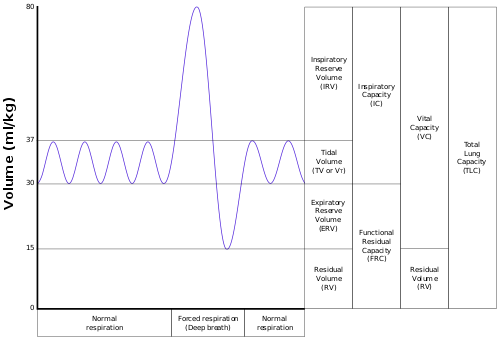Functional residual capacity

Functional Residual Capacity (FRC) refers to the volume of air remaining in the lungs, specifically within the parenchyma tissues, after a passive exhalation. It represents a critical physiological parameter in understanding lung function and evaluating potential respiratory ailments.
Definition[edit]
At the FRC stage:
- The elastic recoil forces exerted by both the lungs and chest wall counterbalance each other.
- There is no active engagement from the diaphragm or any other respiratory muscles.
Composition and Measurement[edit]
FRC consists of two primary volumes:
- Expiratory Reserve Volume (ERV): The extra amount of air that can be expired from the lungs through forced breathing out after regular exhalation.
- Residual Volume (RV): The amount of air that remains in the lungs even after the most forceful expiration.
In an average 80 kg male, FRC is typically around 2400 mL. It is worth noting that:
- FRC cannot be estimated via spirometry since it includes the RV.
- Accurate assessment of RV necessitates specialized techniques such as nitrogen washout, helium dilution, or body plethysmography.
Clinical Significance[edit]
Deviations in FRC, be it elevated or diminished, can be indicative of respiratory disorders:
- Emphysema: In this condition, the lungs become more compliant. Hence, they are more influenced by the outward recoil forces from the chest wall. Consequently, patients with emphysema often exhibit broader chest profiles because they breathe at greater volumes.
- Body Posture & FRC: In healthy individuals, the FRC value varies with changes in body posture. For example, obese individuals typically manifest a reduced FRC when lying supine.
Measurement Techniques[edit]
Two predominant methods for FRC measurement include:
- Helium Dilution Technique: This method involves the patient breathing in a known volume of helium. The concentration of helium is then measured after equilibration, allowing for the estimation of lung volumes.
- Pulmonary Plethysmograph: A body box method where changes in pressure and volume are monitored to calculate lung volumes.
Both these techniques enable medical practitioners to gauge lung functionality, facilitating the diagnosis of an array of respiratory conditions. An accurate evaluation of FRC is pivotal in discerning the extent of a patient's respiratory ailment and in determining suitable therapeutic interventions.
See Also[edit]
|
|
|
Functional_residual_capacity[edit]
-
Lung Volumes Diagram
Ad. Transform your life with W8MD's Budget GLP-1 injections from $75


W8MD offers a medical weight loss program to lose weight in Philadelphia. Our physician-supervised medical weight loss provides:
- Weight loss injections in NYC (generic and brand names):
- Zepbound / Mounjaro, Wegovy / Ozempic, Saxenda
- Most insurances accepted or discounted self-pay rates. We will obtain insurance prior authorizations if needed.
- Generic GLP1 weight loss injections from $75 for the starting dose.
- Also offer prescription weight loss medications including Phentermine, Qsymia, Diethylpropion, Contrave etc.
NYC weight loss doctor appointmentsNYC weight loss doctor appointments
Start your NYC weight loss journey today at our NYC medical weight loss and Philadelphia medical weight loss clinics.
- Call 718-946-5500 to lose weight in NYC or for medical weight loss in Philadelphia 215-676-2334.
- Tags:NYC medical weight loss, Philadelphia lose weight Zepbound NYC, Budget GLP1 weight loss injections, Wegovy Philadelphia, Wegovy NYC, Philadelphia medical weight loss, Brookly weight loss and Wegovy NYC
|
WikiMD's Wellness Encyclopedia |
| Let Food Be Thy Medicine Medicine Thy Food - Hippocrates |
Medical Disclaimer: WikiMD is not a substitute for professional medical advice. The information on WikiMD is provided as an information resource only, may be incorrect, outdated or misleading, and is not to be used or relied on for any diagnostic or treatment purposes. Please consult your health care provider before making any healthcare decisions or for guidance about a specific medical condition. WikiMD expressly disclaims responsibility, and shall have no liability, for any damages, loss, injury, or liability whatsoever suffered as a result of your reliance on the information contained in this site. By visiting this site you agree to the foregoing terms and conditions, which may from time to time be changed or supplemented by WikiMD. If you do not agree to the foregoing terms and conditions, you should not enter or use this site. See full disclaimer.
Credits:Most images are courtesy of Wikimedia commons, and templates, categories Wikipedia, licensed under CC BY SA or similar.
Translate this page: - East Asian
中文,
日本,
한국어,
South Asian
हिन्दी,
தமிழ்,
తెలుగు,
Urdu,
ಕನ್ನಡ,
Southeast Asian
Indonesian,
Vietnamese,
Thai,
မြန်မာဘာသာ,
বাংলা
European
español,
Deutsch,
français,
Greek,
português do Brasil,
polski,
română,
русский,
Nederlands,
norsk,
svenska,
suomi,
Italian
Middle Eastern & African
عربى,
Turkish,
Persian,
Hebrew,
Afrikaans,
isiZulu,
Kiswahili,
Other
Bulgarian,
Hungarian,
Czech,
Swedish,
മലയാളം,
मराठी,
ਪੰਜਾਬੀ,
ગુજરાતી,
Portuguese,
Ukrainian



